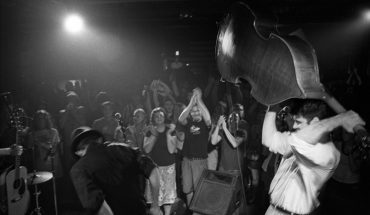by Ann Brooke Raynal
Walk into the barn at Montreat on a Friday evening in summertime and prepare to step out of (or perhaps back in) time. The Stoney Creek Boys play traditional square dance music as they have every Friday night since 1971, as Glenn Bannerman calls the turns. Generations fill the dance floor, and spectators line the old wooden bleachers as the dancers hold hands in a giant circle. The dancers circle left and right, come into the center with clasped hands held high: The dance becomes a shifting human kaleidoscope of mothers and fathers, uncles and children, grandfathers and teenagers. Lots of teenagers. Teens not clutching their cell phones but happily holding the hands of strangers. Teenagers having the time of their lives.
My husband and I bought a house because of a square dance. We were visiting Raleigh friends John and Caryn McNeill at their Montreat cabin over July 4. A Presbyterian minister’s son, my husband Charles had grown up spending the occasional week at Montreat youth conferences or in the homes of his parents’ friends, but I was a stranger to these parts. Yes, Montreat is gorgeous – all misty mountain views, rocky streams, rhododendrons, and darling historic cottages. But the world is full of beautiful places. I wanted what I glimpsed at the barn dance: a community of fine and wholesome people. I wanted it for myself and for my children. Fortunately, my husband felt the same compulsion.
Two months later, we were under contract.
This tiny village, tucked into a cove just north of Black Mountain, has 40 miles of hiking trails, a lake for fishing and boating, summer day camps for kids, tennis courts, and a (frigid) swimming pool. But Montreat is no pre-fab “Olde Towne” village. It’s the real deal: a rugged mountain community, carved out of the wilderness with grit and intentionality.
It’s a place numerous Raleigh families have loved for years, returned to for generations, and made their own.
Montreat’s appeal for city dwellers is obvious. John and Caryn McNeill and their children get up to the mountains whenever dual Raleigh careers (John is a dentist; Caryn, a partner at Smith Anderson) and the sports schedules of their three children will allow. Miles Engell, an assistant professor of biology at N.C. State, enjoys summers at the old family homesite with daughters Munroe and Sophie. Her husband Adam treks up on weekends. The three Bell siblings, Vic, McNair, and sister Fairley Bell Cook, divide their time between Raleigh (and the real estate business they run together) and Montreat, with their respective spouses and children in tow. For these families, Montreat represents that perfect alchemy of family history, outdoor adventure, and serious downtime.
The Bell family has been returning to Montreat for 100 years. The siblings share a cedar shake house on a stone foundation built in 1927 and owned by their grandparents, John and Martha McNair, who met in Montreat. When John McNair walked down Kentucky Road to the barn, the story goes, a young Martha McMillian would throw stones at him. Despite that “rocky” start, love eventually blossomed. Daughter Martha Jane McNair also married a fellow Montreater, Vic Bell Sr., and the Bells became passionate and generous supporters of the place. After Jane Bell’s death, memorials went toward purchasing surrounding wilderness land. The Jane Bell Forest is now a legacy for all to enjoy.
Montreat is “not a fancy place,” Fairley Bell Cook says. “No one dresses up. It’s a relaxed lifestyle. Even our furniture is old and worn down by the generations.” Fancy furnishings wouldn’t survive in most Montreat houses anyway. Roughly half the houses lack central heat and air. Though the Bells’ house is now heated, air conditioning comes in the form of electric fans and a screened-in sleeping porch (a common architectural feature) designed to catch the cool mountain air.
In her college essay, Miles Engell’s daughter, Munroe, addressed the question of “How a place can become part of a person” by writing about her summers in Montreat. The community has been a part of her mother’s family identity from its very inception. Her Gaw grandparents met in Montreat, and their 1906 family home, “Brachenbrae,” was one of the first houses built. “I really appreciate the opportunity to unplug, to go back in time to a simpler way of life,” Miles Engell says.
Though he claims it wasn’t a test, John McNeill brought his fiancée Caryn Coppedge to the mountains in the summer of ’89. The McNeills have been Montreaters since the days of John’s great-grandfather, and his parents bought their own house there in the 1980s. Despite (or maybe because of) being wedged in among John’s 18 first cousins, numerous friends, and family dogs, Caryn took to the place immediately. “I could see the intrinsic goodness and beauty. Not just the physical beauty of the mountains, but the rightness of being with family and enjoying simple pleasures together.” When the couple bought their own house in 2007, it was with an eye toward “handing down that experience to the next generation.”
In any given year, three or four Montreat houses might be sold on the open market. The McNeills started looking in 2004 and found the perfect house three years later. “It’s not old,” Caryn says a little apologetically, of the spacious, hand-hewn log cabin. But what the house lacks in age, it makes up for in grace. The McNeills enjoy stunning mountain views from two long porches. A generous stone patio carved into the hillside behind the house is surrounded by a profusion of old-fashioned hydrangeas. Glossy wide plank pine floors just beg to be skated on in socks. This winter, John crafted a porch swing for the lower porch, complete with cup-holders.
Montreat hasn’t strayed far from its origins in 1905. That’s when a group of North Carolina Presbyterians bought 4,000 acres from an interdenominational group to create a place of rest and reflection for physical and spiritual renewal. They combined the words “mountain” and “retreat” for its name.
At the beginning, as lots were sold, families pitched tents on foundations before they built houses. Even in those early days, these staunch Presbyterians (author Marilynne Robinson famously asked, “Is there any other kind?”) held church retreats, revivals, and conferences and hosted some of the nation’s foremost speakers, preachers, and theologians. (It’s a practice that continues to this day. Preacher Billy Graham may be the town’s most famous resident).
By 1910, the tent village had largely given way to 110 stone and wooden frame houses, and by the 1920s, the Association had built – out of native stone – an auditorium, a church, and a college. In addition, a rushing mountain stream was dammed to create Lake Susan.
These days, the town itself is not much larger than it was in the early 1900s. Roughly 200 houses hold nearly 700 residents, but the population increases dramatically in the summertime, as camps and conferences and family reunions get under way.
The town’s only commercial business resides in the Moore Building, which perches at one end of Lake Susan and spreads its wings over Robert Lake Park below. Inside, you can buy a T-shirt at the Montreat Store, order up an ice cream cone at the Huckleberry cafe, or commandeer a rocking chair to tap into civilization via free wifi – for many residents, it’s their only wifi connection. “Downtown” Montreat is this: the convergence of the Moore Bulding, three mountain streams, a playground, and a lake.
Freedom and Fun
There is only one road into the town, and all visitors enter under enormous stone arches that Montreaters call “the gate.” Many years ago, “gate boys” let visitors and residents in and out, but though gate boys are a thing of the past, Montreaters still feel that physically passing under these arches triggers a psychological response: a sense of safety and homecoming. “The downside to urban living is that kids and adolescents can’t have some of the freedoms they are ready for,” says Miles Engell. “But in Montreat, I can let my child roam. I know she’s somewhere within the gate. She’s having wholesome fun with life-long friends.” Twelve-year-old Alex McNeill relishes the freedom he experiences in Montreat: “I get to say, ‘Bye, Mom, see you at dinner,’ and then go mountain biking or fly-fishing.”
High school sophomore Johnny McNeill enjoys having more downtime in Montreat than he gets in Raleigh. The mountains mean a break from homework and a chance to sleep in (It’s the “best place for napping, as well,” he points out). The McNeills own a DVD player but have no television or cable service. Though their large basement provides such delights as foosball and Ping Pong, both boys point to timeless outdoor pursuits as their preferred pastimes: hanging out with friends, going for ice cream, and playing “capture the flag” at twilight. Other favorite activities include hiking, picnicking and rock-hopping along the mountain streams. Apparently, rock-hopping is to Montreat what tailgating is to ACC football: It’s what you do when you get there. Vic Bell fondly remembers rock-hopping for “hours at a time with all my friends. It was a simpler time. You made your own fun!”
The activity around Montreat, organized and otherwise, points to a distinguishing characteristic of the town: People are hearty and active. It’s a walking, not a driving, place. “I don’t have to drive except to go to the grocery store,” says Miles Engell. And though the biology professor will be working on lesson plans for next semester, she enjoys the ritual of a daily morning hike. “I love that I can walk off the front porch and be on the trail.” Caryn echoes these sentiments: “I watch some of the older folks who live here, and they’re not just walking the trails, they’re blazing them. Seeing our neighbors has given me a taste of what active retirement might look like,” says the 47-year-old lawyer who – for the record – is not retiring any time soon.
The Bells, McNeills, and Engells hasten to add that though Montreat is steeped in history and Presbyterianism, the mixture is slowly changing, and the town is becoming more diverse while still retaining its charm. “People see how good it is, and they want to be part of it,” says Miles.
She’s right, of course. As I write, my family is packing for our first overnight stay in the unheated house we bought in the fall. We’ll be first-generation Montreaters, making new memories in an old house.







